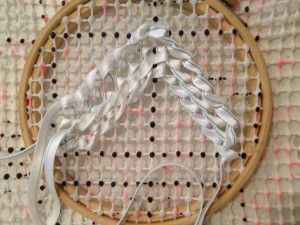Excitingly, many of the artists in Melbourne Now have chosen to draw upon works in the NGV’s extensive Collection. From paintings to photographs to furniture, fashion and textiles, a large number of works from the permanent Collection are being sociably re-hung throughout the exhibition spaces and re-contextualised according to the wonderfully idiosyncratic viewpoints of contemporary artists, designers and jewellers.
Susan Dimasi’s installation, titled A poetic engagement in reproduction #1, 2013, includes a group of eighteenth century brocaded silk fragments and two eighteenth century men’s waistcoats from the International Fashion & Textiles collection. A one-time curator in the Fashion & Textiles department and now artisan director of her own fashion label, MaterialByProduct, Dimasi is well placed to examine these intriguing historical pieces. Positioned centrally in the installation, the fragments will form the starting point for a meditation on the processes of production and reproduction in fashion.
For two afternoons a week during most of Melbourne Now, Dimasi will sit at a purpose-built loom, (made in collaboration with design studio Broached Commissions) located in the centre of the installation. Here she will weave new works that reference the highly decorative language of the brocaded silks which were typically used for upholstery or drapery. Impossibly perfect scrolling ribbons and repeated floral forms will be reiterated by Dimasi in a manner that sees her using the leftover bindings from her fashion practice as weft threads. Once finished, these new woven works will then be cut from the loom and reproduced as digitally-printed textile lengths.
Dimasi’s work is intended to draw attention to the hand of the maker and to encourage visitors to contemplate the craftsmanship implicit in her practice. It is an interesting reflection on new and old systems, and vocabularies, of making.
